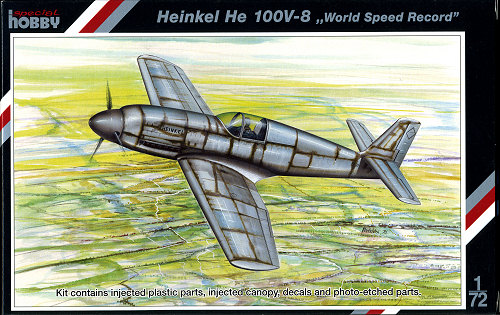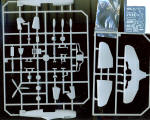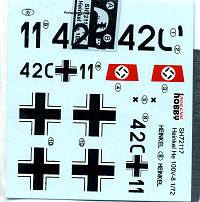
| KIT: | Special Hobby 1/72 He-100v8 'World Speed Record' |
| KIT #: | 72117 |
| PRICE: | $21.20 at GreatModels |
| DECALS: | Two options |
| REVIEWER: | Scott Van Aken |
| NOTES: | Short run kit with etched brass fret |

| HISTORY |
The first prototype He 100 V1 flew on 22 January 1938, only a week after its promised delivery date. The aircraft proved to be outstandingly fast. However it continued to share a number of problems with the 112, notably a lack of directional stability. In addition the Luftwaffe test pilots disliked the high wing loading, which resulted in landing speeds so great that they often had to use brakes right up to the last 100 m of the runway. The ground crews also disliked the design, complaining about the tight cowling which made servicing the engine difficult. The big problem turned out to be the cooling system, largely to no one's surprise. After a series of test flights V1 was sent to Rechlin in March.
The second prototype addressed the stability problems by changing the vertical stabilizer from a triangular form to a larger and more rectangular form. The oil cooling system continued to be problematic so it was removed and replaced with a small semi retractable radiator below the wing. It also received the still experimental DB 601M engine which the aircraft was originally designed for. The M version was modified to run on "C3" fuel at 96 octane, which would allow it to run at higher power ratings in the future.
V2 was completed in March, but instead of moving to Rechlin it was kept at the factory for an attempt on the 100 km closed circuit speed record. A course was marked out on the Baltic coast between Wustrow and Müritz, 50 km apart, and the attempt was to be made at the aircraft's best altitude of 18,000 ft (5,500 m). After some time cleaning out the bugs the record attempt was set to be flown by Captain Herting, who had previously flown the aircraft several times.
At this point Ernst Udet showed up and asked to fly V2, after pointing out he had flown the V1 at Rechlin. He took over from Herting and flew the V2 to a new world 100 km closed circuit record on 5 June 1938, at 634.73 km/h (394.6 mph). Several of the cooling pumps failed on this flight as well, but Udet wasn't sure what the lights meant and simply ignored them.
The record was heavily publicized, but in the press the aircraft was referred to as the "He 112U". Apparently the "U" stood for "Udet". At the time the 112 was still in production and looking for customers, so this was one way to boost sales of the older design. V2 was then moved to Rechlin for continued testing. Later in October the aircraft was damaged on landing when the tail wheel didn't extend, and it is unclear if the damage was repaired.
The V3 prototype received the clipped racing wings, which reduced span and area from 30 ft 10 in (9.4 m) and 155 ft² (14.4 m²), to 24 ft 11 in (7.6 m) and 118.4 ft² (11 m²). The canopy was replaced with a much smaller and more rounded version, and all of the bumps and joints were puttied over and sanded down. The aircraft was equipped with the 601M and flown at the factory.
In August the DB 601R engine arrived from Daimler-Benz and was installed. This version increased the maximum rpm from 2,200 to 3,000, and added methyl alcohol to the fuel mixture to improve cooling in the supercharger and thus increase boost. As a result the output was boosted to 1,776 hp (1,324 kW), although it required constant maintenance and the fuel had to be drained completely after every flight. The aircraft was then moved to Warnemünde for the record attempt in September.
On one of the pre-record test flights by the Heinkel chief pilot, Gerhard Nitschke, the main gear failed to extend and ended up stuck half open. Since the aircraft could not be safely landed it was decided to have Nitschke bail out and let the aircraft crash in a safe spot on the airfield. Gerhard was injured when he hit the tail on the way out, and made no further record attempts.
V4 was to have been the only "production" prototype and was referred to as the "100B" model (V1 through V3 being "A" models). It was completed in the summer and delivered to Rechlin, so it wasn't available for modification into racing trim when V3 crashed. Although the aircraft was unarmed it was otherwise a service model with the 601M, and in testing over the summer it proved to be considerably faster than the 109. At sea level the aircraft could reach 348 mph (560 km/h), faster than the 109E's speed at its best altitude. At 6,560 ft, it improved to 379 mph (610 km/h), topping out at 416 mph (669 km/h) at 16,400 ft before falling again to 398 mph (641 km/h) at 26,250 ft. The aircraft had flown a number of times before its landing gear collapsed while standing on the pad on 22 October. The aircraft was later rebuilt and flying by March 1939.
Although V4 was to have been the last of the prototypes in the original plans, production was allowed to continue with a new series of six aircraft. One of the airframes was selected to replace V3, and as luck would have it V8 (and the subject of this kit) was at the "right point" in its construction and was completed out of turn. It first flew on 1 December but this was with a standard DB 601Aa engine. The 601R was then put in the aircraft on 8 January 1939, and moved to a new course at Oranienberg. After several shakedown flights, Hans Dieterle flew to a new record on 30 March 1939, at 746.6 km/h (463.9 mph). Once again the aircraft was referred to as the He 112U in the press. It is unclear when happened to V8 in the end; it may have been used for crash testing.
V5 was completed like V4, and first flew on 16 November. It was later used in a film about V8's record attempt, in order to protect the record breaking aircraft. At this point a number of changes were made to the design resulting in the "100C" model, and with the exception of V8 the rest of the prototypes were all delivered as the C standard.
V6 was first flown in February 1939, and after some test flights at the factory it was flown to Rechlin on 25 April. There it spent most of its time as an engine testbed. On 9 June the gear failed inflight, but the pilot managed to land the aircraft with little damage and it was returned to flying condition in six days.
V7 was completed on 24 May with a change to the oil cooling system. It was the first to be delivered with armament, consisting of two 20 mm MG/FF in the wings and four 7.92 mm MG17's arranged around the engine cowling. This made the 100 the most heavily armed fighter of its day. V7 was then flown to Rechlin where the armament was removed and the aircraft was used for a series of high speed test flights.
V9 was also completed and armed, but was used solely for crash testing and was "tested to destruction". V10 was originally to suffer a similar fate, but instead ended up being given the racing wings and canopy of the V8 and displayed in the German Museum in Munich as the record–setting "He 112U". It was later destroyed in a bombing attack.
Overheating problems and general failures with the cooling system motors continued to be a problem. Throughout the testing period failures of the pumps ended flights early, although some of the test pilots simply starting ignoring them. In March Kleinemeyer wrote a memo to Ernst Heinkel about the continuing problems, stating that Schwärzler had asked to be put on the problem.
Another problem that was never cured during the prototype stage was a rash of landing gear problems. Although the wide-set gear should have eliminated the gear failures that plagued the 109, the 100's were built very thin and as a result they were no improvement. V2, 3, 4 and 6 were all damaged to various degrees due to various gear failures, a full half of the prototypes.
| THE KIT |
 Though
not in one of the new resealable bags, this kit is a newer molding. There are
two sprues of plastic, one which has the shorter wings of the speed record
aircraft. A one piece prop is provided and the wheels are single moldings.
Engraving is very nicely done and a lot more crisp than on the older kits. There
is a separate fin/rudder with one piece tailplanes. Main gear doors are
photo-etch an
Though
not in one of the new resealable bags, this kit is a newer molding. There are
two sprues of plastic, one which has the shorter wings of the speed record
aircraft. A one piece prop is provided and the wheels are single moldings.
Engraving is very nicely done and a lot more crisp than on the older kits. There
is a separate fin/rudder with one piece tailplanes. Main gear doors are
photo-etch an d
a set of optional photo etch tail wheel doors are supplied. P.e. is also used
for the instrument panel, harness, rudder pedals, inner gear door retraction
struts, and oleo scissors. A single injected plastic canopy is provided that is
perhaps a bit thicker than one would like. As the main sprue is also used for
the 'fighter' version, there are parts that are not used with this boxing. There
is also an acetate sheet to use behind the instrument panel
d
a set of optional photo etch tail wheel doors are supplied. P.e. is also used
for the instrument panel, harness, rudder pedals, inner gear door retraction
struts, and oleo scissors. A single injected plastic canopy is provided that is
perhaps a bit thicker than one would like. As the main sprue is also used for
the 'fighter' version, there are parts that are not used with this boxing. There
is also an acetate sheet to use behind the instrument panel
Instructions are well done with color references in Gunze paints. There are two options. One is the box art record aircraft in overall silver (probably aluminum) with all the seams filled with a brown-green putty. The other is a fake Luftwaffe plane in overall RLM 02. The fuselage coding was actually applied on a piece of butcher paper and then crudely glued on the fuselage. In the photo of this plane, it is all wrinkled and obviously a fake. Decals are by AviaPrint so are nice and thin.
| CONCLUSIONS |
This is a very nice kit that beats the old Lindberg one by miles in terms of everything other than ease of construction. For those of us who like prototype and record aircraft, it is a must for our collections.
| REFERENCES |
http://en.wikipedia.org
August 2007
You can get this kit and many others along with a full line of accessories at www.greatmodels.com
If you would like your product reviewed fairly and quickly by a site that has nearly 400,000 visitors a month, please contact me or see other details in the Note to Contributors.